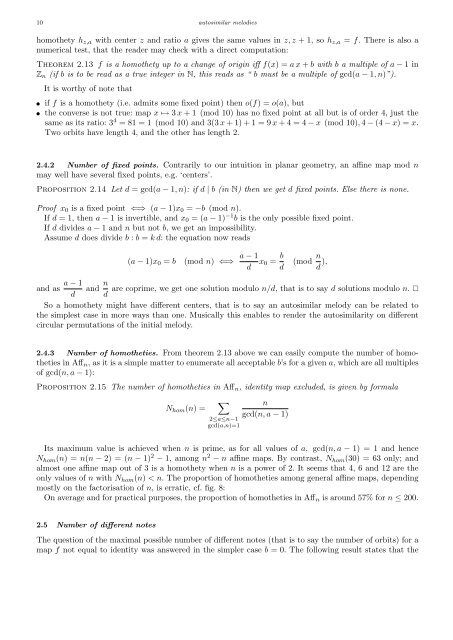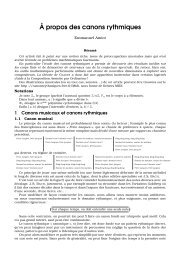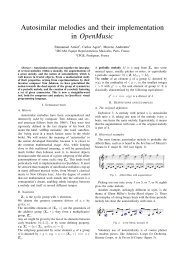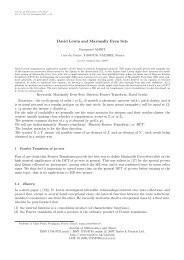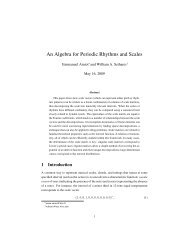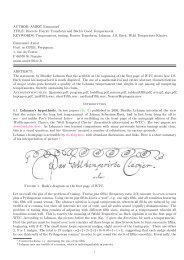Emmanuel Amiot Modèles algébriques et algorithmes pour la ...
Emmanuel Amiot Modèles algébriques et algorithmes pour la ...
Emmanuel Amiot Modèles algébriques et algorithmes pour la ...
Create successful ePaper yourself
Turn your PDF publications into a flip-book with our unique Google optimized e-Paper software.
10 autosimi<strong>la</strong>r melodies<br />
homoth<strong>et</strong>y hz,a with center z and ratio a gives the same values in z, z + 1, so hz,a = f. There is also a<br />
numerical test, that the reader may check with a direct computation:<br />
Theorem 2.13 f is a homoth<strong>et</strong>y up to a change of origin iff f(x) = a x + b with b a multiple of a − 1 in<br />
Zn (if b is to be read as a true integer in N, this reads as “ b must be a multiple of gcd(a − 1, n)”).<br />
It is worthy of note that<br />
• if f is a homoth<strong>et</strong>y (i.e. admits some fixed point) then o(f) = o(a), but<br />
• the converse is not true: map x ↦→ 3 x + 1 (mod 10) has no fixed point at all but is of order 4, just the<br />
same as its ratio: 3 4 = 81 = 1 (mod 10) and 3(3 x + 1) + 1 = 9 x + 4 = 4 − x (mod 10), 4 − (4 − x) = x.<br />
Two orbits have length 4, and the other has length 2.<br />
2.4.2 Number of fixed points. Contrarily to our intuition in p<strong>la</strong>nar geom<strong>et</strong>ry, an affine map mod n<br />
may well have several fixed points, e.g. ‘centers’.<br />
Proposition 2.14 L<strong>et</strong> d = gcd(a − 1, n): if d | b (in N) then we g<strong>et</strong> d fixed points. Else there is none.<br />
Proof x0 is a fixed point ⇐⇒ (a − 1)x0 = −b (mod n).<br />
If d = 1, then a − 1 is invertible, and x0 = (a − 1) −1 b is the only possible fixed point.<br />
If d divides a − 1 and n but not b, we g<strong>et</strong> an impossibility.<br />
Assume d does divide b : b = k d: the equation now reads<br />
(a − 1)x0 = b (mod n) ⇐⇒<br />
a − 1<br />
d x0 = b<br />
d<br />
(mod n<br />
d ),<br />
a − 1<br />
and as and<br />
d<br />
n<br />
are coprime, we g<strong>et</strong> one solution modulo n/d, that is to say d solutions modulo n. <br />
d<br />
So a homoth<strong>et</strong>y might have different centers, that is to say an autosimi<strong>la</strong>r melody can be re<strong>la</strong>ted to<br />
the simplest case in more ways than one. Musically this enables to render the autosimi<strong>la</strong>rity on different<br />
circu<strong>la</strong>r permutations of the initial melody.<br />
2.4.3 Number of homoth<strong>et</strong>ies. From theorem 2.13 above we can easily compute the number of homoth<strong>et</strong>ies<br />
in Affn, as it is a simple matter to enumerate all acceptable b’s for a given a, which are all multiples<br />
of gcd(n, a − 1):<br />
Proposition 2.15 The number of homoth<strong>et</strong>ies in Affn, identity map excluded, is given by formu<strong>la</strong><br />
Nhom(n) = <br />
2≤a≤n−1<br />
gcd(a,n)=1<br />
n<br />
gcd(n, a − 1)<br />
Its maximum value is achieved when n is prime, as for all values of a, gcd(n, a − 1) = 1 and hence<br />
Nhom(n) = n(n − 2) = (n − 1) 2 − 1, among n 2 − n affine maps. By contrast, Nhom(30) = 63 only; and<br />
almost one affine map out of 3 is a homoth<strong>et</strong>y when n is a power of 2. It seems that 4, 6 and 12 are the<br />
only values of n with Nhom(n) < n. The proportion of homoth<strong>et</strong>ies among general affine maps, depending<br />
mostly on the factorisation of n, is erratic, cf. fig. 8:<br />
On average and for practical purposes, the proportion of homoth<strong>et</strong>ies in Affn is around 57% for n ≤ 200.<br />
2.5 Number of different notes<br />
The question of the maximal possible number of different notes (that is to say the number of orbits) for a<br />
map f not equal to identity was answered in the simpler case b = 0. The following result states that the


